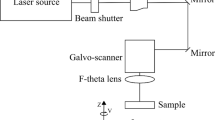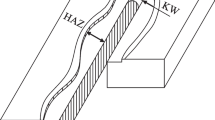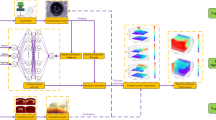Abstract
To manufacture parts with nano- or micro-scale geometry using laser machining, it is essential to have a thorough understanding of the material removal process in order to control the system behaviour. At present, the operator must use trial-and-error methods to set the process control parameters related to the laser beam, motion system, and work piece material. In addition, dynamic characteristics of the process that cannot be controlled by the operator such as power density fluctuations, intensity distribution within the laser beam, and thermal effects can significantly influence the machining process and the quality of part geometry. This paper describes how a multi-layered neural network can be used to model the nonlinear laser micro-machining process in an effort to predict the level of pulse energy needed to create a dent or crater with the desired depth and diameter. Laser pulses of different energy levels are impinged on the surface of several test materials in order to investigate the effect of pulse energy on the resulting crater geometry and the volume of material removed. The experimentally acquired data is used to train and test the neural network's performance. The key system inputs for the process model are mean depth and mean diameter of the crater, and the system outputs are pulse energy, variance of depth and variance of diameter. This study demonstrates that the proposed neural network approach can predict the behaviour of the material removal process during laser machining to a high degree of accuracy.












Similar content being viewed by others
References
Bordatchev EV, Nikumb SK (1999) Laser material-removal as a subject of automatic control. In: Proceedings of the ASPE 14th Annual Meeting, Monterey, California, USA, 236–239
Gonsalves JN, Duley WW (1972) Cutting thin metal sheets with the cw CO2 Laser. J Appl Phys 43(11):4684–4687
Schuocker D (1987) The physical mechanism and theory of laser cutting. In: Belforte D, Morris L (eds) Annual Review of Laser Processing. Industrial Laser Handbook. Pennwell Books, pp 65–79
Duley WW (1976) CO2 lasers effects and applications. Academic Press, New York
Kaplan AAH (1996) An analytical model of metal cutting with a laser beam. J Appl Phys 79(5):2198–2208
Sharkey SJ, Steen WM, Brookfield DJ (1990) Mathematical modeling of continuous wave carbon dioxide laser processing of materials using non-dimensional plots. In: ICALEO Proceedings, pp 441–450
Vicanek M, Simon G (1987) Momentum and heat transfer of an inert gas jet to the melt in laser cutting. J Appl Phys D 20:1191–1196
Schuocker D (1986) Dynamic model of laser cutting including pulsed operation. SPIE Manuf Appl Laser 621:23–30
Schulz W, Simon G, Urbassek HM, Decker I (1987) On laser fusion cutting of metals. J Appl Phys D 20:481–488
Ivarson A, Powell J, Magnusson C (1992) Laser cutting of steels: analysis of the particles ejected during cutting. Welding World 30(5,6):116–125
Yoshiaki A, Hiroshi M, Isamo M, Sadao T (1979) Dynamic behavior in laser gas cutting. Trans JWRI (Welding Research Institute of Osaka University, Japan) 8(2):15–26
Yoshiaki A, Hiroshi M, Isamo M, Sadao T (1981) Quality in laser-gas-cutting and its improvement. Trans JWRI (Welding Research Institute of Osaka University, Japan) 10(2):129–139
Kim MJ, Zhang J (2001) Finite element analysis of evaporating cutting with a moving high energy pulsed laser. Appl Math Model 21:203–220
Kim MJ, Chen ZH, Majumdar P (1993) Finite element modeling of the laser cutting process. J Comput Struct 49:231–241
Kim MJ, Majumdar P (1995) A computational model for high energy laser cutting process. Numer Heat Transfer A 27:717–733
Kaebernick H, Bicleanu D, Brandt M (1999) Theoretical and experimental investigation of pulsed laser cutting. Ann CIRP 48(1):163–166
Toth GJ, Szakacs T, Lorincz A (1993) Simulation of pulsed laser material processing controlled by an extended self-organizing Kohonen feature map. Mater Sci Eng B18(3):281–288
Haykin S (1999) Neural networks - a comprehensive foundation. Prentice-Hall, Upper Saddle River, NJ
Charschan SS (1993) Guide to laser materials processing. Laser Institute of America, CRC Press Inc, Boca Raton, USA
Acknowledgments
The authors would also like to acknowledge the support of the National Research Council of Canada's Integrated Manufacturing Technologies Institute, and the Natural Sciences and Engineering Research Council of Canada.
Author information
Authors and Affiliations
Corresponding author
Neural network training algorithm
Neural network training algorithm
The feedforward and back-propagation stages are shown in the following algorithm.
Step 0. Set the learning rate parameter α to 0.1 and the momentum constant µ to small values from 0.1 to 0.5. Determine the number of hidden layers as well as the number of neurons per layer. Determine the maximum number of iterations. Set the minimum system error E av .
Step 1. Initialize the weights w l ji and biases w l jo for all layers to small random values between -0.1 and +0.1.
Step 2. While the stopping conditions are false, do Steps 3–10.
Step 3. For each training pair (X(n), d(n)) do Steps 4–10, where X(n) is the input signal vector at iteration n and d(n) is the desired response vector at iteration n.
Step 4. Determine the response vector Y1(n) for all the neurons in the first layer using
where W 1(n)is the interconnection weight vector for the first hidden layer neurons and f is the activation function as given by Eq. 2 which is used by the neurons of the first layer.
Step 5. Determine the response of the neurons in each of the following hidden layers as well as the output layer using
where f is the activation function in layer l and Y l−1(n) are the responses of neurons of the preceding layer l.
Step 6. Determine the mean squared error (or system error) E(n) associated with each pattern n using
where summation is done for all the neurons in the output layer l.
Step 7. Determine the average (normalized) system error E av using
where N is the total number of training patterns.
Step 8. Compute the error information terms δ o j (n) and calculate the weight correction terms, Δw o ji (n), for all neurons included in the output layer o using
where the layer l is the layer preceding the output layer o.
Step 9. Compute the error information terms and the weight correction terms for all neurons in the previous (hidden) layers starting with layer l that precedes the output layer and propagate backwards up to the first hidden layer with
where m is the number of neurons in layer l+1, index k refers to neurons in the layer following layer l and index i refers to neurons in the layer preceding layer l.
Step 10. Update weights for all layers using:
Step 11. Test for stopping condition
If the chosen maximum number of iterations is reached or if the normalized system error calculated in Step 7 is smaller than the pre-set value in Step 0, then STOP, otherwise continue.
Rights and permissions
About this article
Cite this article
Yousef, B.F., Knopf, G.K., Bordatchev, E.V. et al. Neural network modeling and analysis of the material removal process during laser machining. Int J Adv Manuf Technol 22, 41–53 (2003). https://doi.org/10.1007/s00170-002-1441-9
Received:
Accepted:
Published:
Issue Date:
DOI: https://doi.org/10.1007/s00170-002-1441-9




